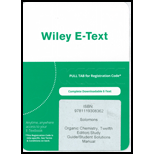
Interpretation:
Thechemical formula and the structure for the given mass spectrum and
Concept introduction:
Mass spectrometry is the detection of ions on the basis of their weights and charges and their abundance.
Mass spectroscopy is a graph with the mass (
Molecular ions formed by EI mass spectrometry are high energy species. Cleavage of a single bond produces a cation and a radical. The Cation can be detected using positive ion mass spectrometry and since the radical is not charged, it will be undetected.
Chain branching or cleavage of a single bond at branch points will occur such that the carbocation formed is more stable.
Carbon-carbon bonds adjacent to atoms with unshared electron pair break readily to form carbocations which are stabilized due to resonance.
Nuclear magnetic resonance spectroscopy is a graph showing the characteristic energy absorption frequencies and intensities of a compound under a magnetic field.
Chemical shifts are the positions of signals along the x-axis in the nuclear magnetic spectroscopy. It gives an idea of how many different hydrogens are present in a given H-NMR for a particular compound.
Want to see the full answer?
Check out a sample textbook solution
Chapter 9 Solutions
ORGANIC CHEMISTRY-ETEXT REG ACCESS
- 4. Deduce the structure of a compound with the molecular formular C8H10O that exhibits the following ¹H NMR and ¹³℃ NMR spectra. (6 pts) Proton NMR 22 7 Carbon NMR There are two. 160 unresolved lines at 130 ppm 140 120 5 Chemical Shift (ppm) 100 80 60 Chemical Shift (ppm) 40 3 20 2V 0arrow_forwardHere are proton NMR data for 1-bromopropane: Ha : triplet (2H) 3.32ppm; Hb : multiplet (2H)1.81ppm; Hc : triplet (3H) 0.93ppm. (Relative integrations shown in parentheses.) a. Through how many bonds can a hydrogen split another hydrogen? b. According to this splitting rule, does Ha split Hc ? c. Is your answer in part a) consistent with the multiplicity listed for peak clusters a and c? d. How many hydrogenssplit Hb ? e. Upon very close inspection of the proton NMR spectrum of 1-bromopropane, you wouldfind that peak cluster b has at least six peaks. Is this consistent with your answer in part d)? f. Speculate as to why any peak cluster with more than four peaks is listed simply as a"multiplet."arrow_forwardThe infrared spectrum of the compound with the mass spectrum shown below lacks any significant absorption above 3000 cm-1. There is a prominent peak near 1740 cm-1 and another strong peak near 1200 cm-1. Propose a structure consistent with the data.arrow_forward
- Following is the mass spectrum of an unknown compound. The two highest peaks are at m/z 120 and 122. Suggest a structure for this compound. (Data from http://webbook.nist.gov/chemistry/.)arrow_forwardThe following is the predicted 1H-NMR spectrum for an unknown compound with molecular formula C6H14O . This compound is a liquid at room temperature, is slightly soluble in water, and reacts with sodium metal with the evolution of a gas.arrow_forward(II) Study this aromatic molecule and answer the following questions: Br H3 NO2 Br a) How many 'H-NMR signals this compound will show? B What will be the splitting (coupling) of H1, H2, and H3? H1 H2 H3 c) Which of the two hydrogens, Hl or H3 will show larger coupling, and which will show smaller coupling? Explain your answer: d) Draw the signal for H2:arrow_forward
- Need some assistance with NMR question please! Thank you so much! Part 3B Set 2. Can 1H NMR spectroscopy be used to differentiate between the two compounds? Briefly explain why or why not. Predict the 1H NMR spectrum for each compound (include integration, multiplicity, and approximate chemical shift). Either draw the actual spectrum or put in a data table format.arrow_forwardBelow are the ¹H NMR spectrum of triphenylmethanol, benzophenone, and bromobenzene. Identify the compound corresponding to each ¹H NMR spectrum and draw the structure next to the ¹H NMR spectrum. Assign ALL peaks in each of the three ¹H NMR spectra. Hint: Conjugated systems (benzophenone) including an electronegative atom will cause a more downfield shift of ring protons in ¹H NMR compared with non-conjugated systems (bromobenzene). 8 8 8 7 7 7 6 6 6 5 5 5 4 PPM 4 PPM 4 PPM 3 3 3 2 2 2 1 1 1 0 0 0arrow_forwardDraw the structure that gives the NMR below. The compound has the molecular formula, C5H10O2. Signal at 3.61(singlet, 3H), 2.32(triplet, 2H), 1.68(sextet, 2H) and 0.99(triplet, 3H). IR shows strong bands at 1710 cm-1and 1200 cm-1(in addition to others). **Make sure to indicate (label) which hydrogen gives which signal.arrow_forward
- Compound E is a volatile organic liquid with a fruity smell. Its mass spectrum is given below. Identify the fragments at m/z 77 and 105, then propose a structure for this compound.arrow_forward(3) These natural compounds will have different numbers of 1H-NMR signals in different NMR solvents like CDC13 and methanol-d4. How many signals do you anticipate for each compound respectively in CDC13 and methanol-d4? LOCH 3 OHC. vanillin OH LOH acetoaminophen HO thymolarrow_forwardThe infrared spectrum of the compound with the mass spectrum shown below lacks any significant absorption above 3000 cm-1. There is a distinct peak near 1740 cm-1 and another strong peak near 1200 cm-1. molecular ion: M+ = 172arrow_forward
 Organic ChemistryChemistryISBN:9781305580350Author:William H. Brown, Brent L. Iverson, Eric Anslyn, Christopher S. FootePublisher:Cengage Learning
Organic ChemistryChemistryISBN:9781305580350Author:William H. Brown, Brent L. Iverson, Eric Anslyn, Christopher S. FootePublisher:Cengage Learning Organic Chemistry: A Guided InquiryChemistryISBN:9780618974122Author:Andrei StraumanisPublisher:Cengage Learning
Organic Chemistry: A Guided InquiryChemistryISBN:9780618974122Author:Andrei StraumanisPublisher:Cengage Learning


